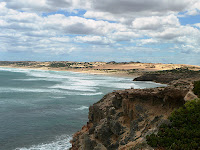The thermometer managed fifteen degrees on first viewing this morning, and would not have risen much more than a further ten during the day. The skies were clear and it was a good day for a drive, a long drive.
With the eski packed and warm clothes on, we set off south from Maitland, pausing in this lovely little town centre to buy a newspaper and then headed off on a dot-to-dot 370 kilometre trip taking in Port Victoria, Minlaton, Warooka, Corny Point, Marion Bay, Warooka (again), Yorketown, Edithburgh, Port Giles, Stansbury, Port Vincent, Ardrossan then back to Maitland.
Port Victoria is on the east coast of the peninsula, situated on the Spencer Gulf and was until 1949 the port from which grain was shipped by sail to Europe via Cape Horn. We were quite astounded to learn that sailing ships were still in use as cargo vessels that late in the piece. Today the town of less than five hundred, is a small quiet little holiday resort for keen fisher folk or those who like to get away from it all. The wide main street runs down to the wharf and both Chris and I were reminded of Raglan on New Zealand’s west coast just out from Hamilton.
Wardong Island and the small peninsula that runs down from the north is an aboriginal reserve. Apart from a long winded tale of “dreaming” and the fact that a permit is required to visit the area, we were unable to ascertain whether anyone actually lives there now, ever has done or what is actually there. We do know however that along the coast here, there are at least eight shipwrecks which told us that the area was a challenge even to the experts.
We drove through endless fields of grain crops, golden in the light. Soon we reached Minlaton, the “Barley Capital of the World” and shrine to Captain Henry Butler. On entering this lovely rural centre with less than a thousand occupants, we were greeted by a red Bristol monoplane housed in a large glass cabinet. This is just part of the Butler memorabilia and history attached to this man who is somewhat a legend around here. He was born in Yorketown in 1889, was a farm boy who had a yen for engineering and air flight, made his way to England and soon made his name as a aircraft mechanic and a pilot and then an instructor. He was a show off entertaining the crowds with his aerobatics and “firsts”. He was the first man to fly over the Gulf Saint Vincent to the Yorke Peninsula, the first to do aerial photography, the first to deliver airmail over water in the southern hemisphere. In 1921 he married, a year later he had a hideous accident and died eighteen months later after numerous operations and reconstruction. Poor wife!
But it actually was the barley and agricultural stories than entranced us more. The women in the Information Centre were a mine of information and happy to hand us a pile of brochures to ensure we did our homework. And so from their instruction and stories we learned:
Barley is Australia’s second largest grain crop and the most common grain crop grown on the Yorke Peninsula.
- Wheat, canola and oats are also grown here on the peninsula.
- Faba beans, field peas, lentils, lupins and vetch are other crops grown for rotational purposes but are also grown for export.
- Australia grows approximately 85% of the world’s supply of lupins – 90% used for stock food and aquaculture with only 4% for human consumption.
Here and on the more southern part of the peninsula, as with the eastern side we later travelled, there was much more sheep grazing than grain growing. There were also more trees left on the landscape whereas further north large expanses had been cleared for cultivation.
Marion Bay was not unlike Port Victoria and Hardwick Bay, although on the southern extreme of the boot-like base of the peninsula. Its charm is in the quiet isolation and lack of sophistication. Quite different to the seaside settlements up the eastern side of the peninsula.
 |
| Wattle Point Wind Farm |
This most southern seaside town as those further north, is most likely more appealing to the city brigade that no doubt pop across the Gulf from Adelaide. The houses are more up to date and the facilities more in line with what modern cosmopolitan folk would wish for in such resorts, however simple.
It has been an excellent day and while it has been a whistle stop trip, we feel that we have made a satisfactory effort to see the Yorke Peninsula, except for those places on the Copper Coast which we will checkout tomorrow morning before heading away and east.


No comments:
Post a Comment